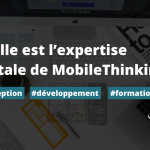In this article, we will study the challenges of the digital transformation in the insurance industry. Challenged by the evolution of behaviors, uses and the technical ecosystem, how is the industry adapting?
What digital transformation
for insurance ?
19/02/2021

The Insurtech
After Fintech, the Insurtech, a contraction of "Insurance" and "Technology" was born out of a relatively simple observation: everyone needs insurance. Home insurance, car insurance, civil liability etc...
The first problem blamed on insurance companies is the lack of transparency. Indeed, very few policyholders do not understand the contracts and guarantees to which they subscribe.
The second point highlighted is customer service that is not reactive enough or even non-existent.
The third problem, and not the least, is cost. The cost of insurance accumulated within a household represents a large budget that is constantly increasing significantly each year.
This movement goes hand in hand with the need for institutional players in the industry to adapt and integrate technology. What are the issues at stake? This is what we will see below.
The first problem blamed on insurance companies is the lack of transparency. Indeed, very few policyholders do not understand the contracts and guarantees to which they subscribe.
The second point highlighted is customer service that is not reactive enough or even non-existent.
The third problem, and not the least, is cost. The cost of insurance accumulated within a household represents a large budget that is constantly increasing significantly each year.
This movement goes hand in hand with the need for institutional players in the industry to adapt and integrate technology. What are the issues at stake? This is what we will see below.
Transparency and user experience
Insurance products are complex, which protects and perpetuates the business of insurers. On the other hand, consumers demand transparency. Concrete cases, presence on social networks and the opinions of policyholders reinforce this need for transparency.
Also, the players are still too late on the mobile, their sites are not always responsive (available on smartphones) which automatically scares away a prospect or even more seriously a policyholder who would like to change his offer.
Another important point is that the policyholder likes to be independent. This requires giving him the right information at the right time and therefore doing important work on the UX of websites as well as on mobile application.
Banks have understood this by investing heavily in the development of their mobile application and e-banking portal.
Today, this gives customers a great deal of freedom, allowing them to carry out banking transactions independently or to monitor the charges applied.
Another benefit of this transparency and autonomy for customers is the ease with which they can interact with their advisor.
Also, the players are still too late on the mobile, their sites are not always responsive (available on smartphones) which automatically scares away a prospect or even more seriously a policyholder who would like to change his offer.
Another important point is that the policyholder likes to be independent. This requires giving him the right information at the right time and therefore doing important work on the UX of websites as well as on mobile application.
Banks have understood this by investing heavily in the development of their mobile application and e-banking portal.
Today, this gives customers a great deal of freedom, allowing them to carry out banking transactions independently or to monitor the charges applied.
Another benefit of this transparency and autonomy for customers is the ease with which they can interact with their advisor.

Improve customer relations
Just because a policyholder likes to be independent doesn't mean he or she doesn't need to ask questions and get advice.
There are a multitude of solutions to do this. Social networks can improve this relationship by providing a real-time response to a prospect. This is also the case for the chat that can be found on websites as proposed by Zendesk.
While a policyholder will contact his insurer mostly when he encounters a problem, CRM becomes the essential tool to maintain a privileged relationship between the two parties. The power to propose solutions that are specific to the customer's situation and needs is the key to building customer loyalty.
The customer/prospect relationship has a direct impact on the commercial aspect.
There are a multitude of solutions to do this. Social networks can improve this relationship by providing a real-time response to a prospect. This is also the case for the chat that can be found on websites as proposed by Zendesk.
While a policyholder will contact his insurer mostly when he encounters a problem, CRM becomes the essential tool to maintain a privileged relationship between the two parties. The power to propose solutions that are specific to the customer's situation and needs is the key to building customer loyalty.
The customer/prospect relationship has a direct impact on the commercial aspect.
Data at the service of fraud detection
Insurance fraud is considered to exist when an accident victim or a service provider consciously receives undue insurance benefits or when an insurance company fails to pay premiums. The prejudice resulting from this amounts to several million francs.
In addition to the internal algorithms used by insurance companies, some InsurTech companies have specialized in fraud detection by analyzing a large amount of data, such as one of the best known of them, Shift Technology.
However, insurer-specific algorithms remain limited since they are based on fraud patterns pre-identified by human analysis and by the volume of data that is specific to the company. There is also a high percentage of false positives. These are cases that are identified as frauds and that are not.
Artificial intelligence should make it possible to combat this percentage of false positives, provided that more data is provided.
In addition to the internal algorithms used by insurance companies, some InsurTech companies have specialized in fraud detection by analyzing a large amount of data, such as one of the best known of them, Shift Technology.
However, insurer-specific algorithms remain limited since they are based on fraud patterns pre-identified by human analysis and by the volume of data that is specific to the company. There is also a high percentage of false positives. These are cases that are identified as frauds and that are not.
Artificial intelligence should make it possible to combat this percentage of false positives, provided that more data is provided.
Exploring new business models
The question of business model innovation is complex, as insurers will have to face drastic changes that they do not master. How to insure a house that is now in a location at risk due to climate change. How to identify responsibility in a car accident involving autonomous vehicles.
And yet these specific cases will become new sources of revenue for companies.
One potential avenue for a new business model is that of platforms. As is the case for a significant number of InsurTech. Even if these startups all start by focusing on a niche, they eventually evolve to position themselves as a service marketplace for insurance products.
And yet these specific cases will become new sources of revenue for companies.
One potential avenue for a new business model is that of platforms. As is the case for a significant number of InsurTech. Even if these startups all start by focusing on a niche, they eventually evolve to position themselves as a service marketplace for insurance products.
Conclusion
As we have just seen, whether it is a question of issues concerning customer relations, fraud detection or business models, we are all undergoing and are all players in the integration of digital, which is the source of many transformations and is a real springboard for innovation in the industry.
The key now is to iterate quickly on potential solutions, to experiment to always be one step ahead.
It is in this key step that MobileThinking can help you. We develop for our customers the future tools that serve the digital transformation of companies.
Stay one step ahead, get on board with MobileThinking to develop tomorrow's services.
The key now is to iterate quickly on potential solutions, to experiment to always be one step ahead.
It is in this key step that MobileThinking can help you. We develop for our customers the future tools that serve the digital transformation of companies.
Stay one step ahead, get on board with MobileThinking to develop tomorrow's services.


